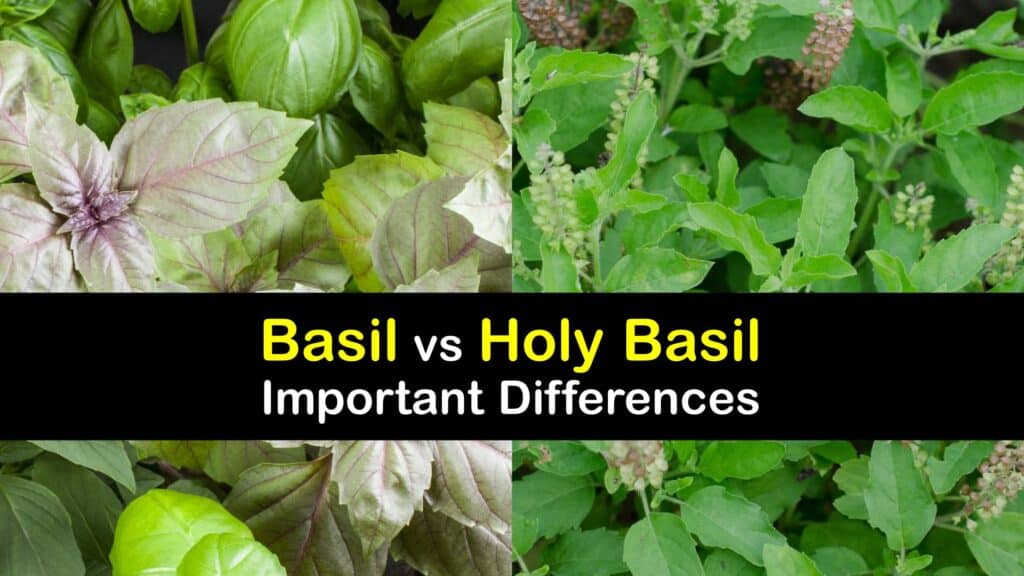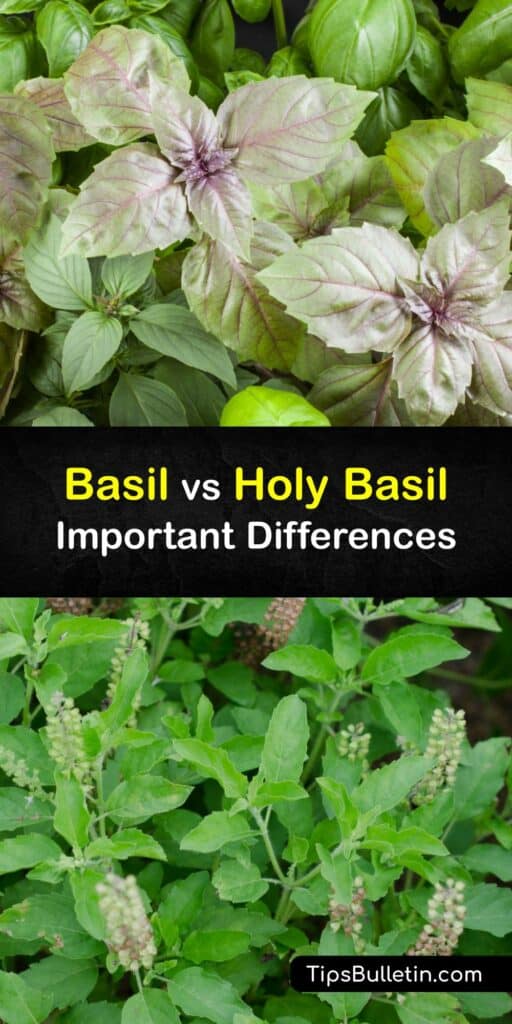Curious about holy basil vs basil? Both types of basil belong to the Ocimum group, with regular basil known as Ocimum basilicum. Exploring the difference between sweet basil and holy basil helps you use these herbs correctly and know when it’s appropriate to use regular basil as a substitute for holy basil.
Basil is an annual in the mint family and is primarily grown for its aromatic leaves worldwide. Most of us have encountered regular or sweet basil in our diets. Many Italian dishes, notably spaghetti sauce, use basil as a seasoning.
Holy basil is less utilized in the United States. Ocimum tenuiflorum, sometimes called Ocimum sanctum, Krishna tulsi, or just Tulasi, is found in Thai cuisine, yet it’s better known for its healing and spiritual properties in Ayurveda medicine. The holy basil plant is native to India and parts of southeast Asia, including Thailand, and is a sacred plant to practitioners of Hindu beliefs.

Understanding the Difference between Sweet Basil and Holy Basil
Differentiating between holy basil vs basil might be challenging because although these herbs are similar in appearance, they are different in taste. As well, the way Thai basil is different from holy basil is in the taste, too. Understanding the difference between sweet basil and holy basil ensures you choose the right one for your garden or use the right herb for your purpose.
Many chefs are curious if sweet basil is a good substitute for holy basil, and while it is possible, there are better options to match the tastes intended for a dish more closely. Explore the differences and similarities between basil and holy basil, find a replacement for fresh basil, and learn about its role in cooking and medicinal properties in this article.

The Appearance of Holy Basil vs Basil
Both holy basil and regular basil have green leaves and stems, which are sometimes difficult to discern. If you have a piece of basil with the stem intact, identification is more straightforward.
The major difference between the two is holy basil’s stem is covered in fine hairs while sweet basil’s stem is smooth. Holy basil may have some purple coloration on the stems, while sweet basil stems are always pure green.
Though it’s trickier to identify from the leaves alone, there are some minor differences. Sweet basil has rounded leaves with a smooth appearance, while holy basil’s leaves are more angular and jagged.
Basil vs Holy Basil – Taste
What is the difference between basil and holy basil in flavor? Despite being related, the two have vastly different flavor profiles. Regular or sweet basil is sweet yet savory. It has an initially peppery tang followed by licorice, mint, and anise notes, and although it is pretty intense, it adds sweetness to a dish.
Fresh basil is well used among the culinary herbs, especially for seasoning meats, sauce, and pesto in much Italian cuisine. Basil will stay fresh in the fridge if it’s kept in water.
Holy basil is intense and spicy, and many people feel a numbing sensation on their tongues when eating it raw. Its flavor profile is similar to black pepper and cloves, more bitter and spicy in comparison to the sweetness of regular basil. Holy basil is used in Asian cuisine and gets spicier as it cooks.
Both basil and holy basil are preserved by blanching in boiling water for a few seconds to retain their pleasant green color. Another idea is to bake the leaves on low heat, then crumble and keep them in an airtight container, or freeze them whole for use later.
Can Sweet Basil be used as a Substitute for Holy Basil?
In a pinch, you could substitute regular basil for holy basil or vice versa, but your meal would likely not go to plan due to their vastly differing tastes. The best substitutions have similar flavors; holy basil and sweet basil miss this mark.
Try fennel to substitute for holy basil. This culinary herb has anise flavor with a kick and comes closer to replicating the slight bitterness of holy basil than sweet basil. Substituting regular basil involves matching its sweetness, so mint, oregano, and tarragon are ideal, depending on what’s in your kitchen or herb garden.
Health Benefits of Sweet Basil and Holy Basil Leaves
Holy basil has long been used in Indian and Ayurvedic medicine and is considered sacred thanks to its healing properties. In Western medicine, holy basil is regarded as an adaptogen; it helps the body respond to stressors. Holy basil reduces inflammation, relieves arthritis, fights bronchitis, heals insect bites, and lowers blood pressure and cholesterol.
While not as prolific as holy basil, sweet basil has its own health benefits, though it is mostly used for culinary purposes. Basil and its essential oil contain antioxidant and anti-inflammatory compounds and a crucial molecule called eugenol, which gives it many desirable properties for reducing disease and remaining healthy.
Other Types of Basil
Sweet and holy basil only scratch the surface of what basil has to offer in the kitchen and the garden. Several basil seeds are available or check your local farmers market to purchase fresh herbs. If you’re curious about adding some variety to your herbs, consider other kinds of basil.
Whether you’re looking for new dried spices or herbs to grow in the garden, every variety of basil is flavorful, and some offer color to your dish or garden bed.
While there are some similarities, especially in appearance, basil and holy basil taste very different, making poor substitutes for each other. While regular basil is peppery and sweet, holy basil is bitter and incredibly spicy.
Sweet basil has some anti-inflammatory and antioxidant properties, but holy basil has a plethora of health benefits and is known globally for its role in easing many diseases and improving overall health.

If you loved this article on holy basil vs basil, please share this brilliant information on the difference between sweet basil and holy basil with your friends and family on Pinterest and Facebook.